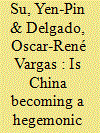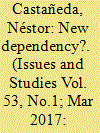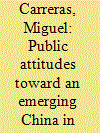|
|
|
Sort Order |
|
|
|
Items / Page
|
|
|
|
|
|
|
| Srl | Item |
| 1 |
ID:
156291


|
|
|
| 2 |
ID:
156293


|
|
|
|
|
| Summary/Abstract |
After the Chinese Communist Party’s 18th Party Congress was held in the fall of 2012, frequently asked questions were: Is Xi Jinping able to rein in the Chinese People’s Liberation Army (PLA) and what is the state of Chinese party-military relations? What are the implications of this status for the PLA in China’s Taiwan policy-making? What is the potential impact of Taiwan’s leadership transition on China’s Taiwan policy and on the PLA’s role?
This author argues that through a stick and carrot approach, Xi has become the leader of China, and has been able to rein in the PLA. His proactive and assertive approach in the context of China’s growing capabilities has empowered him to control the discourse of Taiwan policy. In these circumstances, the PLA will continue to be one joint actor within the relevant apparatus executing Taiwan policy without its own agenda. Uncertainty as a result of the ruling party rotation in Taiwan is unlikely to change the PLA’s role.
|
|
|
|
|
|
|
|
|
|
|
|
|
|
|
|
| 3 |
ID:
156292


|
|
|
|
|
| Summary/Abstract |
This paper focuses on the most recent trends of Chinese finance (foreign direct investment (FDI) and development loans) in Latin America and their impact on economic development. In particular, this paper explores the economic and institutional factors that attract loans and FDI from China to Latin America. Based on data from the Chinese Ministry of Commerce and the United Nations on Chinese FDI and development loans to Latin America, this article argues that Chinese capital flows to the region, rather than politically motivated, are mainly motivated by trade interests, the evolution of the market of commodities, and natural resources-related policy goals. These capital flows are functional to the Chinese government’s use of soft power in the region, but these goals are secondary to market-based interests.
|
|
|
|
|
|
|
|
|
|
|
|
|
|
|
|
| 4 |
ID:
156294


|
|
|
|
|
| Summary/Abstract |
Since the start of the 21st century, it is clear that China has increasingly turned its attention to Latin America. Although not included in China’s “One Belt, One Road” initiative officially, Latin America has already garnered substantial commitment from China as a result of the latter’s financial funding for development projects and the enhancement of two-way trade relations.
In recent years, scholarly research has tended to analyze China’s financial clout and its impact on the governmental domestic and external decisions of Latin American countries. In this study, my purpose is to examine China’s financial initiative and its influence on development projects in Latin America.
With the advent of a “new normal” in China, Xi Jinping and Li Keqiang respectively proposed a “1+3+61+3+6” model and “3×33×3” model in 2014 and 2015 — a reflection of China’s assertive economic diplomacy during the Xi era. Their plan was to have China adopt a more active position toward the provision of financial loans to Latin American nations.
China’s financial funds and construction assistance have been poured into key infrastructural projects, such as those related to power generation and transportation in Ecuador and Argentina. It can be expected that such projects satisfy the needs of both the people as well as the government, and contribute to genuine development there. On top of the involvement of China in relation to technology, equipment, and design, an expansion in cooperation and partnership is currently and will also be in the future the best reward for China.
|
|
|
|
|
|
|
|
|
|
|
|
|
|
|
|
| 5 |
ID:
156295


|
|
|
|
|
| Summary/Abstract |
In the past two decades, China has substantially increased its economic presence in Latin America. The impressive rate of economic growth in China has resulted in a voracious appetite for Latin American commodities and energy sources. China has also become a major investor in the region, and has loaned billions of dollars to Latin American countries. This paper evaluates how aware Latin American citizens are of this increased economic presence of China, and also studies citizens’ attitudes toward the rising influence of China in Latin America. Public attitudes toward the Chinese economic and political model, and evaluations of the Chinese popular culture are also presented and discussed. The evidence suggests that the image of China is improving in Latin America as a result of its new economic role in the region. However, Chinese soft power faces several limitations in the region. The Chinese political and economic models, and the Chinese popular culture are still not very attractive in Latin America.
|
|
|
|
|
|
|
|
|
|
|
|
|
|
|
|
| 6 |
ID:
156296


|
|
|
|
|
| Summary/Abstract |
What is the representation of East Asia in Latin American legislatures? Existing studies have focused on individual politicians of East Asian descent such as Alberto Fujimori, former president of Peru, but no systematic research has been done on the political representation of East Asia in Latin America. In order to fill this gap, this study analyzes the descriptive and substantive aspects of East Asian representation in Latin America. For the descriptive dimension, this article reviews the composition of legislators of East Asian descent in each Latin American country and finds that people of Japanese descent are “overrepresented” in the Peruvian and Argentine lower houses, while people of Korean and Chinese descent are underrepresented. Using the Brazilian Chamber of Deputies as an example, this study also reveals that deputies of East Asian descent differ from other deputies in terms of their political careers. As for the substantive dimension, this study focuses on Brazilian deputies’ responses to the Twin Ocean Railroad project, one of the largest Chinese infrastructure projects in Latin America. The statistical test performed in this study shows that the deputies tend to be members of the Brazil–Peru–China Pro-Twin Ocean Railroad Caucus if they are affiliated with the Brazil–Japan Caucus, if they are from a wealthier state, or if their performance in the last election was good. In addition, they are not likely to be members of the caucus if they are affiliated with the Partido da Social Democracia Brasileira (PSDB), an important opposition party.
|
|
|
|
|
|
|
|
|
|
|
|
|
|
|
|
|
|
|
|
|